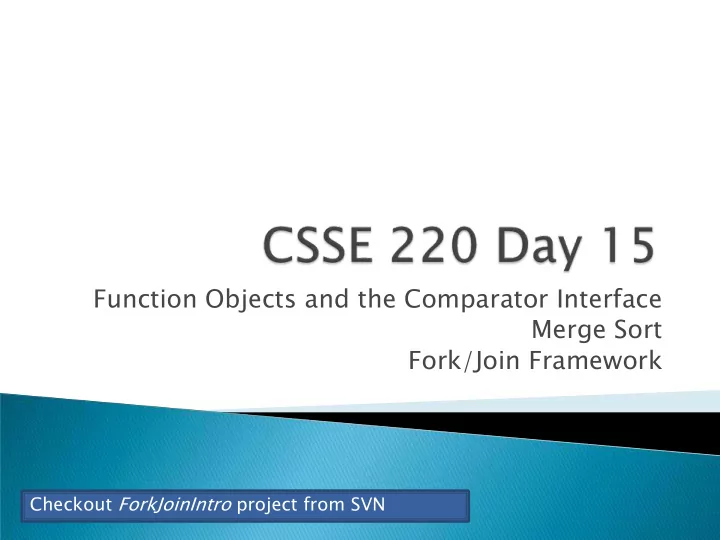

Function Objects and the Comparator Interface Merge Sort Fork/Join Framework Checkout ForkJoinIntro project from SVN
Merge sort recap Introduction to function objects, Comparator arator Parallelism with the Fork/Join Framework
Basic recursive idea: ◦ If list is length 0 or 1, then it‟s already sorted ◦ Otherwise: Divide list into two halves Recursively sort the two halves Merge the sorted halves back together
If list is length 0 or 1, then it‟s already sorted Otherwise: ◦ Divide list into two halves ◦ Recursively sort the two halves ◦ Merge ge the sorted halves back together Merge n items n items merged n items merged Merge n/2 items Merge n/2 items Merge n/4 Merge n/4 n items Merge n/4 Merge n/4 items items merged items items etc etc Merge 2 Merge 2 Merge 2 Merge 2 n items etc items items items items merged
Another way of creating reusable code
Java libraries provide efficient sorting algorithms ◦ Arrays.sort (…) and Collections.sort (…) But suppose we want to sort by something other than the “natural order” given by compareTo() Function objects to the rescue!
Objects defined to just “wrap up” functions so we can pass them to other (library) code For sorting we can create a function object that implements Comparator Let’s try it!
Function objects and recursion meet multicore computers Some slides and examples derived from Dan Grossman‟s materials at http://www.cs.washington.edu/homes/djg/teachingMaterials/
Sequential programming : one thing happens at a time ◦ No longer the case! Parallel programming : multiple things happen simultaneously Major challenges and opportunities ◦ Programming ◦ Algorithms ◦ Data We‟ll just scratch the surface in CSSE 220
Parallel code is often much harder to write than sequential Free ride from the CPEs ◦ From 1980-2005 performance of same sequential code doubled every two years No one knows how to continue this! ◦ Speed up clock rate? Two much heat Memory can‟t keep up ◦ But the “wires” keep getting smaller, so… Put multiple processors on same chip!
Run multiple totally different programs ◦ Operating system handles this ◦ Uses time-slicing plus multiple cores Multiple things at once in one program ◦ We‟ll play with this today!
Parallelism : Use more resources for a faster answer Concurrency : Correctly and efficiently allow simultaneous access to data
CS1 idea: Writing a program is like writing a recipe for a cook Parallelism: slicing lots of potatoes Concurrency: sharing stove burners
+ + + + + + + + + + + + + + + Example: Sum elements of a large array Use divide-and-conquer! ◦ Parallelism for the recursive calls
Specifically for recursive, divide-and- conquer parallelism ◦ Will be in Java 7 standard libraries, but available in Java 6 as a downloaded .jar file Fork : splitting off some code that can run in parallel with the original code ◦ Like handing a potato to a helper Join : waiting for some forked code to finish ◦ Like waiting for the potato slices from the helper
Set a sequential threshold ◦ A size below which we just “slice „ em ourselves” Library needs to “warm up” ◦ Java Virtual Machine optimizes as it runs Wait until your computer has more processors Here there be dragons! ◦ Memory-hierarchy issues ◦ Race conditions ◦ We‟re ignoring lots of gory details!
Find a partner for HW15 You‟ll: ◦ Write some code ◦ Run some experiments ◦ Write a lab report This is the second time we‟ve tried this: ◦ Enjoy playing with the tools and ideas ◦ Ask questions! Follow the written homework instructions carefully. There‟s a lot more independent learning here than we‟ve been doing so far.
Recommend
More recommend